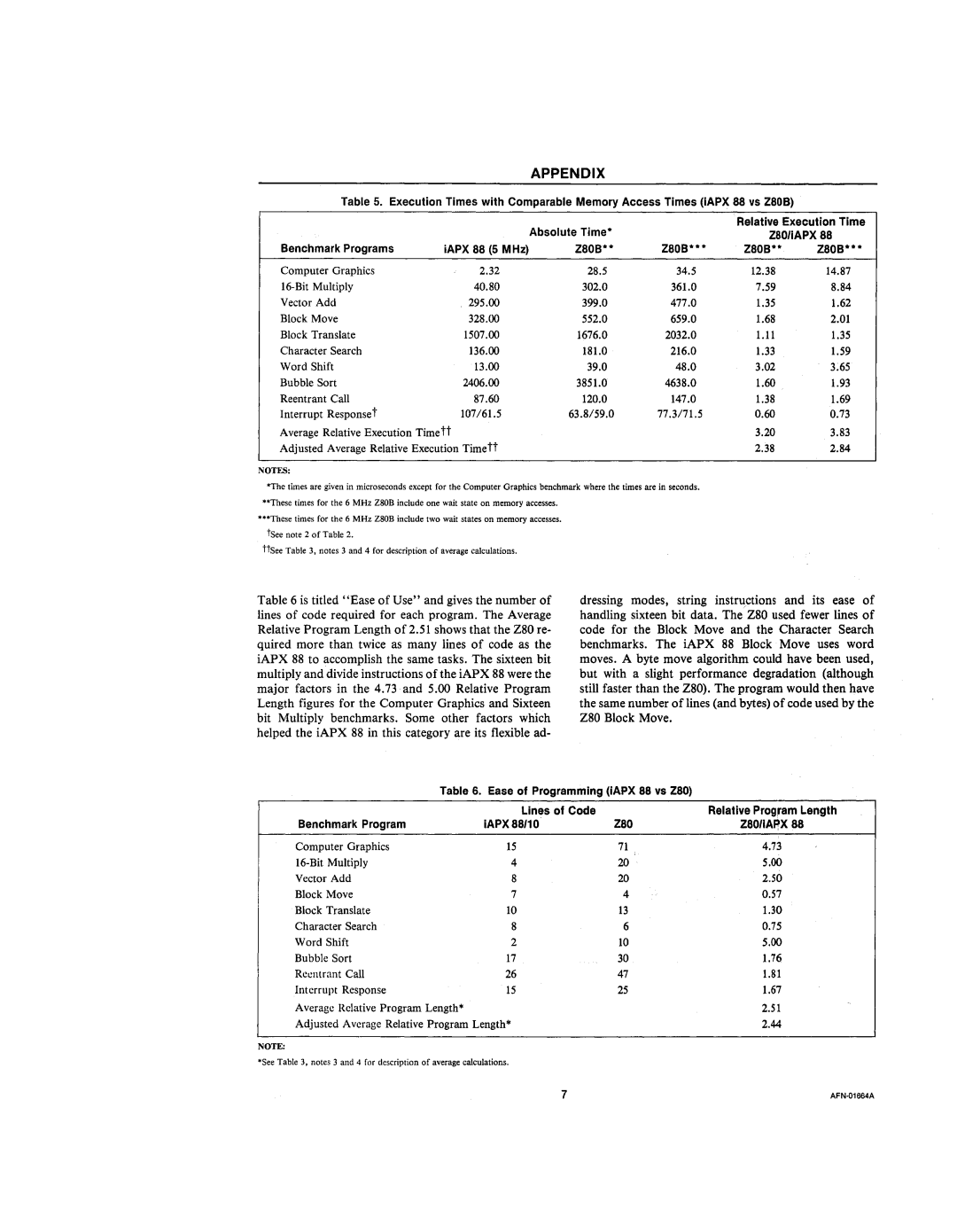
APPENDIX
Table 5. Execution Times with Comparable Memory Access Times (iAPX 88 vs Z80B) |
| ||||
|
| Absolute Time· |
| Relative Execution Time | |
|
|
| Z80/iAPX 88 | ||
Benchmark Programs |
|
| Z80B··· | ||
iAPX 88 (5 MHz) | Z80B·· | Z80B·· | Z80B··· | ||
Computer Graphics | 2.32 | 28.5 | 34.5 | 12.38 | 14.87 |
40.80 | 302.0 | 361.0 | 7.59 | 8.84 | |
Vector Add | 295.00 | 399.0 | 477.0 | 1.35 | 1.62 |
Block Move | 328.00 | 552.0 | 659.0 | 1.68 | 2.01 |
Block Translate | 1507.00 | 1676.0 | 2032.0 | 1.11 | 1.35 |
Character Search | 136.00 | 181.0 | 216.0 | 1.33 | 1.59 |
Word Shift | 13.00 | 39.0 | 48.0 | 3.02 | 3.65 |
Bubble Sort | 2406.00 | 3851.0 | 4638.0 | 1.60 | 1.93 |
Reentrant Call | 87.60 | 120.0 | 147.0 | 1.38 | 1.69 |
Interrupt Response t | 107/61.5 | 63.8/59.0 | 77.3171.5 | 0.60 | 0.73 |
Average Relative Execution Timett |
|
| 3.20 | 3.83 | |
Adjusted Average Relative Execution Time tt |
|
| 2.38 | 2.84 | |
NOTES:
·The times are given in microseconds except for the Computer Graphics benchmark where the times are in seconds. "These times for the 6 MHz Z80B include one wait state on memory accesses.
***These times for the 6 MHz Z80B include two wait states on memory accesses. tSee note 2 of Table 2.
ttSee Table 3, notes 3 and 4 for description of average calculations.
Table 6 is titled "Ease of Use" and gives the number of lines of code required for each program. The Average Relative Program Length of 2.51 shows that the Z80 re- quired more than twice as many lines of code as the iAPX 88 to accomplish the same tasks. The sixteen bit multiply and divide instructions of the iAPX 88 were the major factors in the 4.73 and 5.00 Relative Program Length figures for the Computer Graphics and Sixteen bit MUltiply benchmarks. Some other factors which helped the iAPX 88 in this category are its flexible ad-
dressing modes, string instructions and its ease of handling sixteen bit data. The Z80 used fewer lines of code for the Block Move and the Character Search benchmarks. The iAPX 88 Block Move uses word moves. A byte move algorithm could have been used, but with a slight performance degradation (although still faster than the Z80). The program would then have the same number of lines (and bytes) of code used by the Z80 Block Move.
Table 6. Ease of Programming (iAPX 88 vs Z80)
| Lines of Code |
| Relative Program Length |
Benchmark Program | iAPX 88/10 | Z80 | Z80/iA~X 88 |
Computer Graphics | 15 | 71 | 4.73 |
4 | 20 | 5.00 | |
Vector Add | 8 | 20 | 2.50 |
Block Move | 7 | 4 | 0.57 |
Block Translate | 10 | 13 | 1.30 |
Character Search | 8 | 6 | 0.75 |
Word Shift | 2 | 10 | 5.00 |
Bubble Sort | 17 | 30 | 1.76 |
Reentrant Call | 26 | 47 | 1.81 |
Interrupt Response | 15 | 25 | 1.67 |
Average Relative Program Length· |
|
| 2.51 |
Adjusted Average Relative Program Length" |
| 2.44 | |
NOTE:
·See Table 3, notes 3 and 4 for description of average calculations.
7 | AFN·01664A |
